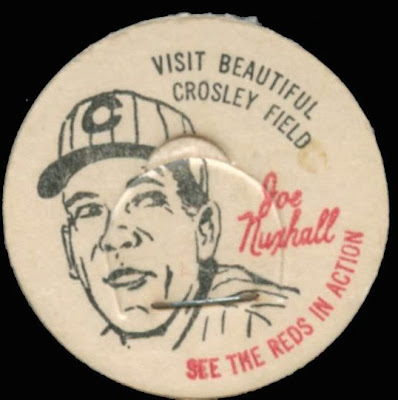They may not be the prettiest cards I own, but these 1956 Topps cards can tell a story even when they're scuffed like this. Since I have picked up a scanner to use, I've been slowly showing some of my recent additions to my collection...and here are some more of those:
Johnny Antonelli is from Upstate New York (as am I) and has become a part of two bloggers' sites: Night Owl (
who featured a much nicer-looking 1956 than this one) grew up near one of his tire franchises and Jeff over at Cardboard Catastrophies (
who also has a much nicer 1956 Topps than this) has a player set devoted to Antonelli. Between those two, there's enough background on him as a player...so I'll just focus on the card.
One of the neat things about the 1956 Topps cards is the second full-color action shot. With the background added to the image, the cards really "pop" in a way that they 1954 and 1955 cards (which also had a second image, but no backgrounds) didn't. And the shot of Antonelli delivering a pitch to an unseen competitor is just great.
As for Luis Arroyo, he's just posing for the cameraman here. Yet the stadium backdrop makes the card something more than it would have been without it.
Arroyo actually pitched for the Pirates in 1956. He started the year in the minors and was dealt away in May. The Puerto Rican native was best known for a baffling screwball, as well as being part of the latter days of the Yankee dynasty that made the World Series each year he was with them.
Showing off his windup is Jim Hearn, who was instumental in helping the Giants to overcome a 13 1/2-game deficit to with the 1951 pennant.
But Hearn will be forever remembered by me as
my very first 1952 Topps high #...a $4 purchase. When I think of him, that will always be the first thing that comes to my mind.
Billy Klaus is shown here turning a play at second against the Yanks' Andy Carey. I like the way the picture shows tha dust getting kicked up as Klaus throws to first and Carey attempts to take him out. That's how baseball should be played, not the silly "neighborhood play" sometimes used today. Yes, I get that it's there to prevent injuries...but it doesn't seem right.
I just noticed that Klaus is the only non-pitcher in this group of cards.
So, we go back to the pitchers. In fact, this is the third Giant hurler out of the five cards. Liddle came to the tam from the Braves along with Johnny Antonelli -- and Billy Klaus, for that matter -- in 1954, and was part of that year's World Series team. In fact, he was the pitcher to threw the pitch to Vic Wertz that Wille Mays caught and still nailed the runner at the plate...the one play that is still shown from that Series all these years later.






































